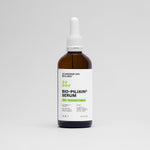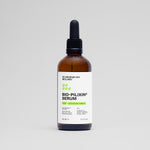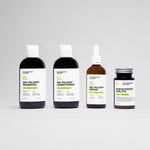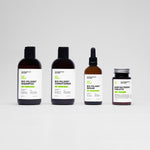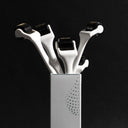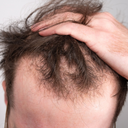Hair loss is tough. 70% of women with hair loss feel devastated about it [1]. 88% say it negatively affects their lives. This shows how deeply hair loss can impact self-esteem and quality of life.
But with so many treatment options available in 2024, finding the right solution can be hard. Last year, 66% of people with non-scarring hair loss bought at least one over-the-counter (OTC) hair product [2]. Yet, the majority of them saw no improvement after using the product.
Additionally, 80% of those with scarring hair loss tried OTC products. But, almost all of them found the products ineffective. Many spent over $500 on these products. Often, there was no insurance coverage, adding financial stress.
In this guide, we’ll help you find the best hair loss solutions of 2024. We will explore scientific, natural, and holistic treatments. Whether you're looking to prevent hair loss or regrow hair, we've got you covered.
Table of content
Understanding Hair Loss
Before we dive into the solutions, let's first understand what causes hair loss. This will help you choose the most effective treatments and prevent further hair loss.
You are born with about 5 million hair follicles, and don't get more after birth [3]. Each hair follicle goes through three stages:
- Anagen Phase: This is the growth phase and lasts 1 to 6 years. About 90-95% of your hair is in this phase at any time.
- Catagen Phase: This is a short phase where the hair stops growing and gets ready to shed.
- Telogen Phase: This is the resting phase, lasting 2 to 3 months. The old hair falls out, and new hair starts to grow.
Disruption of this cycle leads to hair loss. Healthy hairs turn into thin, weak hairs (vellus hairs) that eventually fall out.
What Causes Hair Loss?
Hair loss can happen for many reasons. Let's look at some of the main causes:
1. The Role of Aging and Genetics
As we age, our hair changes. The hair cycle shortens, leading to shorter anagen phases and longer telogen phases. This means hair falls out faster and takes longer to grow back.
Genetics play a big part too. Studies have found over 200 genetic markers linked to male pattern baldness [4]. This means if your father had hair loss, you're more likely to experience it, too. In fact, men whose fathers had hair loss are 2.5 times more likely to have hair loss themselves [4].
2. How Hormonal Changes Impact Your Hair
Hormones play a significant role in your hair's health [5]. Androgens like testosterone and dihydrotestosterone (DHT) are key players. They turn small, light hairs into thick, dark hairs. But too much DHT can shrink hair follicles, leading to hair loss.
Other hormones also influence hair growth:
- Oestrogen: Helps keep hair in the anagen phase, promoting growth.
- Progesterone: Can counteract the effects of DHT.
- Thyroid Hormones: Regulate hair growth; both hyperthyroidism and hypothyroidism can cause hair loss.
- Prolactin: Elevated levels can contribute to hair loss in both men and women.
Thus, hormonal imbalances can disrupt the hair cycle and lead to hair loss.
3. Stress and Hair Loss: The Hidden Connection
Stress can trigger hair loss by raising levels of cortisol, the stress hormone [6]. High cortisol can push hair into the resting (telogen) phase prematurely. This causes more hair to fall out.
4. Nutrient Deficiencies and Their Effects on Hair
Good nutrition is vital for healthy hair. Nutrients protect your hair from damage and support its growth [7]. Without enough vitamins and minerals, your hair can become weak, dry, and more likely to fall out.
Different Types of Hair Loss Explained
Hair loss can occur in different ways, depending on the underlying cause. Let's look at the main types:
1. Androgenetic Alopecia: Pattern Baldness
Androgenetic alopecia (pattern baldness) is the most common type of hair loss. This type of hair loss is due to genetics and hormones like DHT.
It affects both men and women. In men, it usually starts with a receding hairline and thinning on the top of the head. In women, it often shows up as overall thinning, especially at the crown.
2. Alopecia Areata: Patchy Hair Loss
Alopecia areata causes sudden, patchy hair loss. This happens when the immune system mistakenly attacks hair follicles. The result is round, smooth bald patches on the scalp or other parts of the body.
Sometimes, hair can grow back on its own, but other times, treatment may be necessary.
3. Telogen Effluvium: Hair Loss Triggered by Stress
Telogen effluvium is a type of hair loss triggered by stress. High stress levels can push a large number of hair follicles into the resting (telogen) phase. After a few months, these hairs fall out all at once.
Telogen Effluvium loss is usually temporary. This means hair often regrows with stress management.
As your leading source for hair health information over the past 4 years, we never compromise on accuracy. When it comes to your health, you deserve information you can truly rely on - and earning your trust is our top priority.
Here's how Scandinavian Biolabs ensures every piece of content meets the highest standards of accuracy and integrity:
- Credentialed Experts: Our reviewers are actively practicing doctors and medical researchers
- Stringent Reviews: Content undergoes rigorous editing by subject specialists and review by a practicing doctor.
- Evidence-Based: We rely on well-established research from trusted scientific sources like peer-reviewed journals and health authorities.
- Full Transparency: Our editorial standards, writer credentials, reviewer credentials, correction process, and funding are all publicly documented.
- Independent Voice: While we do promote products, we operate in a vacuum to business operations. Our main goal is just an unwavering commitment to providing medically-sound guidance.
You can count on Scandinavian Biolabs to consistently deliver the trustworthy health information you deserve. Read our Editorial Standards.
Scientific Hair Loss Solutions
When it comes to treating hair loss, scientific advancements offer several effective options. Let's explore these in more detail.
Research-Proven Medications to Reverse Hair Loss
Medications can be a powerful tool in combating hair loss. Here, we will look at three research-proven options: minoxidil, finasteride, and spironolactone.
1. Minoxidil (Rogaine): The Go-To Solution for Hair Regrowth
Minoxidil, known as Rogaine, is a popular and effective treatment for hair loss. It works by making the hair growth (anagen) phase longer [8]. This helps hair follicles grow bigger, leading to thicker and longer hair. Minoxidil also opens potassium channels in blood vessels, which helps hair grow.
Studies with 634 patients showed that minoxidil is an effective hair loss treatment [9].
2. Finasteride (Propecia): A Solution for Hair Loss
Finasteride, known as Propecia, is an effective medication for hair loss. It works by blocking the enzyme 5-alpha-reductase, which converts testosterone to dihydrotestosterone (DHT) [10]. Lowering DHT levels helps prevent hair loss and promotes regrowth.
Studies involving 458 patients showed that finasteride boosted hair count [11].
3. Spironolactone: A Lesser-Known Hair Loss Medication
Spironolactone blocks the effects of testosterone on the skin and hair [12]. This reduces total testosterone levels, which helps prevent hair loss.
A meta-analysis found that spironolactone improved hair loss in 56.60% of cases [13]. The improvement rate was even higher at 65.80% when used in combination with other treatments.
Hair Transplants to Combat Hair Loss

For a more permanent solution to hair loss, hair transplants can work. Let's discuss the different techniques.
1. FUT Hair Transplants: The Traditional Method
FUT (Follicular Unit Transplantation) is a traditional method for hair transplants. It involves removing a strip of scalp from the back of the head. This is then divided into tiny grafts and implanted into balding areas.
Research shows that FUT can regenerate hair density and coverage. In a study of 112 patients, FUT demonstrated significant hair regrowth [14]. Many patients experienced a noticeable improvement in hair density and appearance.
2. FUE Hair Transplants: A Modern Approach
FUE (Follicular Unit Extraction) is a modern hair transplant technique. During the procedure, doctors extract and transplant individual hair follicles to balding areas. This method is less invasive and leaves minimal scarring.
Research involving 20 patients showed promising results [15]. Patients who underwent FUE had a follicle survival rate of 30% at 3 months, 67% at 6 months, and 78% at 12 months.
Low-Level Laser Light Therapy (LLLT): Does It Work?
Low-Level Laser Light Therapy (LLLT) is a non-invasive treatment which uses red light to stimulate hair growth. While the exact mechanism of LLLT is not known, the most widely accepted one is that it can lead to increased cellular proliferation, growth factors, and inflammatory mediators, and increased oxygen supply. Several studies have also shown that LLLT can decrease inflammation, which may in turn activate hair growth.[25]
Studies have shown that LLLT can be effective for both men and women [16]. In large randomised controlled trials, LLLT led to significant hair regrowth.
PRP Therapy: A Safe and Effective Hair Loss Treatment
Platelet-Rich Plasma (PRP) therapy is another non-invasive treatment for hair loss. In this procedure, a small amount of your blood is drawn. It is then processed to concentrate the platelets. Finally, the platelets are injected into your scalp, which helps stimulate hair growth.
Research shows that PRP is effective in treating hair loss. In fact, 83% of studies found PRP to be successful in treating androgenetic alopecia (AGA) [17]. Also, unlike some other treatments, PRP has minimal side effects.
Holistic Approaches to Combat Hair Loss

Natural methods can help fight hair loss too. Let's look at how diet, stress management, and scalp health can keep your hair healthy and strong.
A Healthy Diet is Vital to Reversing Your Hair Loss
What you eat can help make your hair stronger and healthier. Key nutrients like protein, vitamins C, E, and D, biotin, omega-3s, iron, and zinc are essential.
Including these nutrients in your diet can help reverse hair loss and keep your hair healthy. For example, protein strengthens hair, vitamins C and E protect it, and vitamin D helps hair grow. To learn more click here.
Manage Stress to Treat Your Hair Loss
Stress can cause hair loss by raising the stress hormone cortisol. Practices like meditation, journaling, and deep breathing lower stress. For example, studies show mindfulness can reduce stress levels by over 50% [18]. This helps protect your hair.
Scalp Health = Hair Health
Keeping your scalp healthy is key to having strong, beautiful hair. If your scalp is unhealthy, your hair can become weak and brittle. Studies show that different scalp conditions can harm hair quality [19].
But, the good news is, treating the scalp can reverse these effects. Here are some tips to improve your scalp health:
- Keep Your Scalp Clean: Regularly wash your hair to remove dirt and oil.
- Moisturise: Use a conditioner or scalp oil to keep your scalp hydrated.
- Avoid Harsh Chemicals: Stay away from products with harsh chemicals that can irritate your scalp.
- Massage Your Scalp: Regular massages can increase blood flow and promote hair growth.
Proven Natural Solutions for Hair Loss

Natural remedies can also help fight hair loss. Coconut oil, pumpkin seed oil, caffeine products, and our special formula can help your hair grow healthier.
Curcuma: Nature’s Hair Strengthener
Curcuma, also known as turmeric, is a powerful natural remedy for hair. It has anti-inflammatory and antioxidant properties that support hair growth and scalp health [20]. Curcuma also contains curcumin, which can penetrate the scalp and nourish hair follicles.
Research shows that Curcuma extract can slow hair loss and increase hair growth [21].
Pumpkin Seed Oil: A Hidden Gem for Hair Regrowth
Pumpkin seed oil (PSO) has been shown to block dihydrotestosterone (DHT) in animal, the hormone that causes androgenetic alopecia. This in turn can promote reduced hair loss and increased hair growth in those suffering from this condition.
In a study with 76 men, those who took PSO for 24 weeks saw a 40% increase in hair [22]. The placebo group only saw a 10% increase.
Caffeine-Infused Products: Energise Your Hair
Caffeine can boost hair growth by increasing cell metabolism [23]. As a phosphodiesterase inhibitor, it raises cyclic adenosine monophosphate levels. This helps cells grow faster.
Research shows that even small amounts of caffeine (0.001% and 0.005%) can trigger hair follicle growth [24].
The Perfect Blend: Nature and Technology for Hair Growth
Natural solutions are great, but they can be made even better with science. Our products combine the best of nature and technology to give you the best of both worlds.
Scandinavian Biolabs offers nature-inspired, effective hair care solutions free from sulphates and silicones.
Key ingredients like Capilia Longa™** derived from turmeric support hair growth. Our Bio-Pilixin® formula also includes an amino acid complex to help strengthen hair, and caffeine and niacinamide to support scalp stimulation.
Takeaway
Hair loss is a significant concern for many, deeply affecting self-esteem and quality of life. While finding the right solution can be challenging with the plethora of options available in 2024, understanding the causes and types of hair loss is essential.
From medical treatments like minoxidil, finasteride, and hair transplants to holistic approaches involving diet, stress management, and natural remedies like curcuma and pumpkin seed oil, there are numerous ways to combat hair loss. With the right knowledge and resources, you can find the most suitable treatment for your hair loss and regain confidence.
By combining the best of nature and technology, Scandinavian Biolabs offers effective, science-backed solutions to support healthy hair growth.
References
[1] Aukerman, E. L., & Jafferany, M. (2022). The psychological consequences of androgenetic alopecia: A systematic review. Journal of Cosmetic Dermatology, 22(1), 89-95. https://doi.org/10.1111/jocd.14983
[2] Ingrassia, J. P., Buontempo, M. G., Alhanshali, L., Akoh, C. C., Glick, S., Shapiro, J., & Sicco, K. L. (2023). The financial burden of alopecia: A survey study. International Journal of Women's Dermatology, 9(4), e118. https://doi.org/10.1097/JW9.0000000000000118
[3] Qi, J., & Garza, L. A. (2014). An Overview of Alopecias. Cold Spring Harbor Perspectives in Medicine, 4(3). https://doi.org/10.1101/cshperspect.a013615
[4] Hagenaars, S. P., Hill, W. D., Harris, S. E., Ritchie, S. J., Davies, G., Liewald, D. C., Gale, C. R., Porteous, D. J., Deary, I. J., & Marioni, R. E. (2017). Genetic prediction of male pattern baldness. PLoS Genetics, 13(2). https://doi.org/10.1371/journal.pgen.1006594
[5] Grymowicz, M., Rudnicka, E., Podfigurna, A., Napierala, P., Smolarczyk, R., Smolarczyk, K., & Meczekalski, B. (2020). Hormonal Effects on Hair Follicles. International journal of molecular sciences, 21(15), 5342. https://doi.org/10.3390/ijms21155342
[6] Liang, W., Zhao, Y., Cai, B., Huang, Y., Chen, X., Ni, N., Wang, Y., Lin, Z., Lin, C., & Huang, K. (2024). Psychological stress induces hair regenerative disorders through corticotropin-releasing hormone-mediated autophagy inhibition. Biochemical and biophysical research communications, 699, 149564. https://doi.org/10.1016/j.bbrc.2024.149564
[7] Goldberg, L. J., & Lenzy, Y. (2010). Nutrition and hair. Clinics in dermatology, 28(4), 412–419. https://doi.org/10.1016/j.clindermatol.2010.03.038
[8] Messenger, A. G., & Rundegren, J. (2004). Minoxidil: mechanisms of action on hair growth. The British journal of dermatology, 150(2), 186–194. https://doi.org/10.1111/j.1365-2133.2004.05785.x
[9] Randolph, M., & Tosti, A. (2021). Oral minoxidil treatment for hair loss: A review of efficacy and safety. Journal of the American Academy of Dermatology, 84(3), 737–746. https://doi.org/10.1016/j.jaad.2020.06.1009
[10] Zito, P. M., Bistas, K. G., Patel, P., & Syed, K. (2024). Finasteride. In StatPearls. StatPearls Publishing.
[11] Piraccini, B. M., Blume-Peytavi, U., Scarci, F., Jansat, J. M., Falqués, M., Otero, R., Tamarit, M. L., Galván, J., Tebbs, V., Massana, E., & Topical Finasteride Study Group (2022). Efficacy and safety of topical finasteride spray solution for male androgenetic alopecia: a phase III, randomized, controlled clinical trial. Journal of the European Academy of Dermatology and Venereology : JEADV, 36(2), 286–294. https://doi.org/10.1111/jdv.17738
[12] Wang, C., Du, Y., Bi, L., Lin, X., Zhao, M., & Fan, W. (2023). The Efficacy and Safety of Oral and Topical Spironolactone in Androgenetic Alopecia Treatment: A Systematic Review. Clinical, Cosmetic and Investigational Dermatology, 16, 603-612. https://doi.org/10.2147/CCID.S398950
[13] Aleissa M. (2023). The Efficacy and Safety of Oral Spironolactone in the Treatment of Female Pattern Hair Loss: A Systematic Review and Meta-Analysis. Cureus, 15(8), e43559. https://doi.org/10.7759/cureus.43559
[14] Kumaresan, M., & Subburathinam, D. M. (2020). Longevity of Hair Follicles after Follicular Unit Transplant Surgery. Journal of cutaneous and aesthetic surgery, 13(4), 292–297. https://doi.org/10.4103/JCAS.JCAS_44_20
[15] Elariny, A. F., Ghozlan, N., Wasief, S., Moussa, A. E., & Eldeeb, M. E. (2022). Evaluation of efficacy of follicular unit extraction versus follicular unit extraction with platelet rich plasma in treatment of cicatricial alopecia. Journal of cosmetic dermatology, 21(11), 5931–5937. https://doi.org/10.1111/jocd.15213
[16] Pillai, J. K., & Mysore, V. (2021). Role of Low-Level Light Therapy (LLLT) in Androgenetic Alopecia. Journal of Cutaneous and Aesthetic Surgery, 14(4), 385-391. https://doi.org/10.4103/JCAS.JCAS_218_20
[17] Gentile, P., & Garcovich, S. (2020). Systematic Review of Platelet-Rich Plasma Use in Androgenetic Alopecia Compared with Minoxidil®, Finasteride®, and Adult Stem Cell-Based Therapy. International journal of molecular sciences, 21(8), 2702. https://doi.org/10.3390/ijms21082702
[18] Gherardi-Donato, E. C. D. S., Gimenez, L. B. H., Fernandes, M. N. F., Lacchini, R., Camargo Júnior, E. B., Díaz-Serrano, K. V., Melchior, M., Pérez, R. G., Riquelme-Galindo, J., & Reisdorfer, E. (2023). Mindfulness Practice Reduces Hair Cortisol, Anxiety and Perceived Stress in University Workers: Randomized Clinical Trial. Healthcare (Basel, Switzerland), 11(21), 2875. https://doi.org/10.3390/healthcare11212875
[19] Tosti, A., & Schwartz, J. R. (2021). Role of scalp health in achieving optimal hair growth and retention. International journal of cosmetic science, 43 Suppl 1, S1–S8. https://doi.org/10.1111/ics.12708
[20] Srivilai, J., Phimnuan, P., Jaisabai, J., Luangtoomma, N., Waranuch, N., Khorana, N., Wisuitiprot, W., Scholfield, C. N., Champachaisri, K., & Ingkaninan, K. (2017). Curcuma aeruginosa Roxb. essential oil slows hair-growth and lightens skin in axillae; a randomised, double blinded trial. Phytomedicine : international journal of phytotherapy and phytopharmacology, 25, 29–38. https://doi.org/10.1016/j.phymed.2016.12.007
[21] Pumthong, G., Asawanonda, P., Varothai, S., Jariyasethavong, V., Triwongwaranat, D., Suthipinittharm, P., Ingkaninan, K., Leelapornpisit, P., & Waranuch, N. (2012). Curcuma aeruginosa, a novel botanically derived 5α-reductase inhibitor in the treatment of male-pattern baldness: a multicenter, randomized, double-blind, placebo-controlled study. The Journal of dermatological treatment, 23(5), 385–392. https://doi.org/10.3109/09546634.2011.568470
[22] Cho, Y. H., Lee, S. Y., Jeong, D. W., Choi, E. J., Kim, Y. J., Lee, J. G., Yi, Y. H., & Cha, H. S. (2014). Effect of pumpkin seed oil on hair growth in men with androgenetic alopecia: a randomized, double-blind, placebo-controlled trial. Evidence-based complementary and alternative medicine : eCAM, 2014, 549721. https://doi.org/10.1155/2014/549721
[23] Cho, Y. H., Lee, S. Y., Jeong, D. W., Choi, E. J., Kim, Y. J., Lee, J. G., Yi, Y. H., & Cha, H. S. (2014). Effect of pumpkin seed oil on hair growth in men with androgenetic alopecia: a randomized, double-blind, placebo-controlled trial. Evidence-based complementary and alternative medicine : eCAM, 2014, 549721. https://doi.org/10.1155/2014/549721
[24] Fischer, T. W., Hipler, U. C., & Elsner, P. (2007). Effect of caffeine and testosterone on the proliferation of human hair follicles in vitro. International journal of dermatology, 46(1), 27–35.
https://doi.org/10.1111/j.1365-4632.2007.03119.x
[25] Pillai JK, Mysore V. Role of Low-Level Light Therapy (LLLT) in Androgenetic Alopecia. J Cutan Aesthet Surg. 2021 Oct-Dec;14(4):385-391. doi: 10.4103/JCAS.JCAS_218_20. PMID: 35283601; PMCID: PMC8906269.

